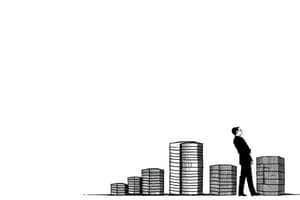Podcast
Questions and Answers
What does incidence refer to in the context of taxes?
What does incidence refer to in the context of taxes?
- Who effectively bears the tax (correct)
- Who benefits from government services
- Who legally pays the tax (correct)
- The total revenue generated by the tax
What is tax shifting?
What is tax shifting?
The shifting of tax burden from legal taxpayers to economic payers after market adjustment.
Which of the following components are involved in incidence?
Which of the following components are involved in incidence?
- Changes in taxes on imports
- Changes in consumer preferences
- Changes in prices of labor (correct)
- Changes in capital prices (correct)
What is the distribution of capital ownership?
What is the distribution of capital ownership?
In the short run, factors are _____
In the short run, factors are _____
How is incidence typically measured?
How is incidence typically measured?
What does differential incidence examine?
What does differential incidence examine?
Match the following studies with their descriptions:
Match the following studies with their descriptions:
What is a key advantage of General Equilibrium?
What is a key advantage of General Equilibrium?
What characterizes the analytical approach in General Equilibrium?
What characterizes the analytical approach in General Equilibrium?
In a competitive market, who bears the greater burden of an excise tax?
In a competitive market, who bears the greater burden of an excise tax?
Flashcards are hidden until you start studying
Study Notes
Tax Incidence Overview
- Incidence determines who absorbs the tax burden, with statutory incidence being the legal taxpayer and economic incidence describing the ultimate burden after market adjustments.
Tax Shifting Explained
- Tax burden can shift from legal to economic payers following market adjustments.
- Forward shifting occurs when firms raise prices to pass costs onto consumers.
- Backward shifting involves passing costs onto less mobile factors like land and labor.
Components of Incidence
- Incidence sources include variations in labor, capital, and land prices.
- Use cases reflect changes to consumer goods prices.
- Model flexibility allows consideration of individuals as both laborers and capital owners.
Capital Ownership Concentration
- Ownership of capital is highly unequal, with the top 1% controlling 54% ($19.2 trillion) and the bottom 50% holding only 0.6% ($0.021 trillion).
Time Frame in Tax Incidence
- Short run considers fixed factors, intermediate run treats total capital and labor as static yet mobile, while the long run remains adaptable to shifts in saving and labor supply.
Measurement of Incidence
- Typically assessed on an annual basis, recent methodologies account for lifetime incidence in relation to overall lifetime income.
Studies on Revenue Disposition
- Differential incidence focuses on varying tax impacts, typically with a fixed government expenditure context.
- Balanced Budget Incidence studies the effects of tax increases that fund expanded government services.
Market Adjustment Study Types
- Partial Equilibrium evaluates a single market's effects, assuming minimal influence from other markets.
- General Equilibrium analyzes all market interactions, providing a comprehensive view of impacts.
Advantages of General Equilibrium
- Incorporates complex, explicit interactions between markets.
- Unveils unexpected consequences in tax incidence analysis.
General Equilibrium Approaches
- Analytical Approach is precise for small tax changes, using limited market models for simplicity.
- Numerical Approach addresses multiple effects but may struggle with interpretability, referred to as the "black box problem."
Partial Equilibrium and Excise Tax
- In competitive markets, the party with more inelastic demand or supply carries a greater tax burden.
- A flatter supply curve combined with a steeper demand curve shifts more burden to consumers.
Studying That Suits You
Use AI to generate personalized quizzes and flashcards to suit your learning preferences.




